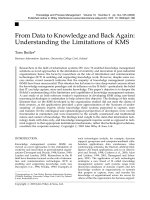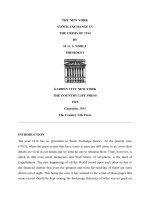The Era of Uncertainty pdf
Bạn đang xem bản rút gọn của tài liệu. Xem và tải ngay bản đầy đủ của tài liệu tại đây (1.37 MB, 254 trang )
ffirs.indd viffirs.indd vi 6/30/11 3:00:17 PM6/30/11 3:00:17 PM
The Era of Uncertainty
ffirs.indd iffirs.indd i 6/30/11 3:00:17 PM6/30/11 3:00:17 PM
ffirs.indd iiffirs.indd ii 6/30/11 3:00:17 PM6/30/11 3:00:17 PM
The Era of Uncertainty
GLOBAL INVESTMENT STRATEGIES
FOR INFLATION, DEFLATION,
AND THE MIDDLE GROUND
François Trahan
Katherine Krantz
John Wiley & Sons, Inc.
ffirs.indd iiiffirs.indd iii 6/30/11 3:00:17 PM6/30/11 3:00:17 PM
Copyright © 2011 by François Trahan and Katherine Krantz. All rights reserved.
Published by John Wiley & Sons, Inc., Hoboken, New Jersey.
Published simultaneously in Canada.
No part of this publication may be reproduced, stored in a retrieval system,
or transmitted in any form or by any means, electronic, mechanical, photocopy-
ing, recording, scanning, or otherwise, except as permitted under Section 107
or 108 of the 1976 United States Copyright Act, without either the prior written
permission of the Publisher, or authorization through payment of the appropri-
ate per-copy fee to the Copyright Clearance Center, Inc., 222 Rosewood Drive,
Danvers, MA 01923, (978) 750-8400, fax (978) 646-8600, or on the Web at
www.copyright.com. Requests to the Publisher for permission should be addressed
to the Permissions Department, John Wiley & Sons, Inc., 111 River Street,
Hoboken, NJ 07030, (201) 748-6011, fax (201) 748-6008, or online at
www.wiley.com/go/permissions.
Limit of Liability/Disclaimer of Warranty: While the publisher and author have
used their best efforts in preparing this book, they make no representations or
warranties with respect to the accuracy or completeness of the contents of this
book and specifically disclaim any implied warranties of merchantability or fitness
for a particular purpose. No warranty may be created or extended by sales repre-
sentatives or written sales materials. The advice and strategies contained herein
may not be suitable for your situation. You should consult with a professional
where appropriate. Neither the publisher nor author shall be liable for any loss
of profit or any other commercial damages, including but not limited to special,
incidental, consequential, or other damages.
For general information on our other products and services or for technical sup-
port, please contact our Customer Care Department within the United States
at (800) 762-2974, outside the United States at (317) 572-3993, or fax (317)
572-4002.
Wiley also publishes its books in a variety of electronic formats. Some content that
appears in print may not be available in electronic books. For more information
about Wiley products, visit our web site at www.wiley.com.
Library of Congress Cataloging-in-Publication Data:
Trahan, Francois, 1969–
The era of uncertainty : global investment strategies for inflation, deflation, and
the middle ground / Francois Trahan and Katherine Krantz.
p. cm.
Includes index.
ISBN 978-1-118-02773-8 (hardback); 978-1-118-13407-8 (ebk); 978-1-118-13409-2
(ebk); 978-1-118-13408-5 (ebk)
1. Investment analysis. 2. Macroeconomics. 3. Uncertainty. 4. Business
cycles. I. Krantz, Katherine, 1972– II. Title.
HG4529.T733 2011
332.6—dc22
2011016570
Printed in the United States of America
10 9 8 7 6 5 4 3 2 1
ffirs.indd ivffirs.indd iv 6/30/11 3:00:17 PM6/30/11 3:00:17 PM
To Ben Bernanke . . . thanks for the material.
ffirs.indd vffirs.indd v 6/30/11 3:00:17 PM6/30/11 3:00:17 PM
ffirs.indd viffirs.indd vi 6/30/11 3:00:17 PM6/30/11 3:00:17 PM
vii
Contents
Foreword xiii
Preface xvii
Acknowledgments xxi
Part I Why “Macro Matters” 1
Chapter 1 What Is Macro, and Why Should Investors Care? 3
Macro Explains More Than 70 Percent of Equity Returns 5
Macro’s Role in Bubble-Mania 7
Chapter Summary 14
Chapter 2 The Ever-Changing Macro Landscape 17
Macro in the Age of Globalization 17
The Increasing Role of Macro in the Years Ahead 22
Learning from Macro-Driven Markets of the Past 28
Chapter Summary 33
vii
ftoc.indd viiftoc.indd vii 7/1/11 1:37:29 PM7/1/11 1:37:29 PM
Chapter 3 Harnessing the Power of the Business
Cycle in Investing 35
Macro Is the Bedrock of Successful Investing 37
Chapter Summary 42
Chapter 4 The Pitfalls of Ignoring Macro Influences:
Accidental Success 43
Macro Lessons Are Learned through Experience 44
Chapter Summary 48
Part II The Roots of the New Era of Uncertainty:
The Credit Crisis 49
Chapter 5 A View from the Front Lines 51
The Bubble Intensifi es 55
Slaying of the Bear 57
Chapter Summary 58
Chapter 6 In the Weeds 61
The Fog of War 62
The Bubble Was Predictable! 67
And the End Was Foreseeable . . . Macro Could Have Helped 71
Chapter Summary 76
Part III Current Policies Are Leading Us
Down an Unsustainable Path 79
Chapter 7 No More Tools in the Toolbox 81
A Breakdown in the Traditional Economic Model of
the United States 83
viii Contents
ftoc.indd viiiftoc.indd viii 7/1/11 1:37:29 PM7/1/11 1:37:29 PM
Contents ix
It’s All About the Consumer! 85
Exports Are Not Enough 89
Chapter Summary 93
Chapter 8 The Government’s Un-Safety Net 95
Infl ation Enters the Picture 97
Spinning Our Wheels 98
Nowhere Fast 101
Chapter Summary 103
Chapter 9 Kicking the Can Down the Road 105
QE Was an Experiment 105
We’re All Keynesians Now…Unfortunately? 108
Uncertainty Kills Growth 111
The State and Local Time Bomb 114
The Privatization Option 118
No Short-Term Fixes 120
Chapter Summary 122
Chapter 10 Threats to Righting the Path of Policy 125
Mobility Threatens Austerity 125
Inequality and Protectionism 128
Business Cycle Trends Could Exacerbate the Policy Conundrum 130
Chapter Summary 131
Part IV Investing for an Uncertain Future 133
Chapter 11 A Closer Look at Inflation 135
Anatomy of Infl ation in the United States 136
The Consumer IS Exposed to Food and Energy 140
ftoc.indd ixftoc.indd ix 7/1/11 1:37:29 PM7/1/11 1:37:29 PM
x Contents
Policies to Avoid Defl ation Often Lead to Infl ation 142
Pushing on a String 147
Infl ation has Social and Political Consequences 150
Market Indications of Infl ation 153
Chapter Summary 156
Chapter 12 Strategies for Investing in Inflationary and
Deflationary Environments 159
Conventional Wisdom—Hedging for Higher Infl ation 160
Making the Turn—Hedging for Slower Growth 165
Policy Responses Bring About Extremes 170
Disinfl ation versus Defl ation 171
Mild Defl ation versus Defl ationary Spiral 173
Fixed Income Is a Defl ationary Safe Haven 177
The Middle Ground 178
Goldilocks in the Emerging Markets 180
Chapter Summary 181
Part V Unintended Consequences and
Creative Solutions 183
Chapter 13 Unintended Consequences 187
QE = WMD? 187
Chapter Summary 193
Chapter 14 Creative Alternatives for the Future 195
The War on the Defi cit 196
Chapter Summary 202
ftoc.indd xftoc.indd x 7/1/11 1:37:29 PM7/1/11 1:37:29 PM
Contents xi
Epilogue: The Financial Services Industry in the Era of Uncertainty 205
Notes 207
About the Authors 215
About the Digital Companion 217
Index 219
ftoc.indd xiftoc.indd xi 7/1/11 1:37:29 PM7/1/11 1:37:29 PM
ftoc.indd xiiftoc.indd xii 7/1/11 1:37:29 PM7/1/11 1:37:29 PM
xiii
Foreword
Pick your own cliché: You can’t see the forest for the trees;
hindsight is 20/20. However you want to phrase it, there is some
truth to these statements, particularly when it comes to the broad
macro trends that affect fi nancial markets. Macro market trends are
sometimes like one of those magic picture posters or an optical illusion
with a dual image: It doesn’t make sense at fi rst, but as soon as you
see the hidden image, it’s impossible to un-see it.
Over the past several years, investors have been through many
of these “a-ha!” moments as we have witnessed a series of once-
in-a-generation economic and market moves. Take a look at what
happened during the height of the credit crisis in 2008. During that
year, the S&P 500 Index experienced its worst fall since the 1930s,
dropping 37 percent. Only 25 of the stocks in that index posted
positive performance for the year. Taking a look at the other 475
companies shows that the variance in performance was signifi cant—
for example, stocks in the consumer staples sector fell only 15 percent,
while those in the fi nancial sector lost more than 55 percent.
For those of us who are professional investors focused on active
management, the most important call that could have been made
was to predict that risk assets were headed over a cliff. Equity markets
took a hard hit, and only the severity of that hit was up for debate.
Investors who were focused only on the traditional bottom-up fun-
damentals that drive stock prices (industry positioning, strength
of management, cash fl ows, etc.) and who were looking for com-
petitive advantages that would help individual stock prices weather
the storm no doubt experienced their “a-ha” moment sometime
around October 2008—a month in which the S&P 500 Index fell
almost 17 percent. At that point, the landscape was certainly not a
pretty sight, and it became clear to almost everyone that top-down
macro forces were the hidden picture in the image that could no
longer be un-seen.
xiii
fbetw.indd xiiifbetw.indd xiii 6/30/11 3:00:04 PM6/30/11 3:00:04 PM
xiv Foreword
Merely recognizing that top-down forces can overwhelm markets
is only half the battle; the more important half is fi guring out how
to interpret these forces and investing accordingly. The real trick
in interpreting and profi ting from macro trends lies in decoding
the signals sent by the ebb and fl ow of the business cycle, and few
people in the fi nancial industry have done this better than François
Trahan.
Over the years, François’ insightful analyses of the business
cycle have led to market calls that have both benefi tted investors
on the upside and (more important to many) protected them
from losses on the downside. François’ incredible track record in
successfully interpreting the trends that can be found in leading
indicators and other macroeconomic data have also led to his well-
deserved reputation as an expert in sector rotation—providing
investors positioned on both the long and short sides of the market
with opportunities to profi t from his ideas. In my opinion, his most
important and infl uential macro prediction to date was his call in
the middle of the last decade when he predicted that the worst
housing crisis in American history would soon be upon us, and that
it would have far-ranging implications for both the global economy
and world fi nancial markets.
In 2005, François used his business-cycle-investment framework
to shed light on how investment bubbles were both created and
destroyed. By defi nition, it’s impossible for the investment public as
a whole to know when markets are in the midst of a bubble (otherwise,
there wouldn’t be bubbles). François’ research, however, showed
that not only did bubbles exhibit fairly predictable patterns, but
more importantly, that markets appeared to be in the stranglehold
of a real estate mania at that very time. In retrospect, signs of the real
estate bubble could have been obvious to everyone (consider that
the phrase “liar loans” was being used in a completely non-ironic
context), but they weren’t. François’ research showed that the real
estate market was exhibiting most of the telltale signs of a bubble
in its late stages, but at the time, his fi ndings were considered out-
of-consensus and somewhat controversial. Even more alarming was
his conclusion that the fallout of the bubble bursting could reach
much further than just the housing market. Many investors (includ-
ing his own employer at the time) chose to ignore the implications
of his research, and learned an expensive lesson about the macro
behavior of markets during a severe downturn. Those who saw the
fbetw.indd xivfbetw.indd xiv 6/30/11 3:00:05 PM6/30/11 3:00:05 PM
Foreword xv
bigger picture and acted accordingly, however, were spared at least
some of the pain.
Markets do not need to be in the grip of a mania or in the midst
of historic collapse in order for top-down analysis to be important; in
the age of increasing globalization, the signifi cance of macro infl u-
ences even during benign times is likely to increase. The players in
the global economy are growing increasingly interdependent, and
policy and investment decisions made on one side of the world
almost inevitably affect markets on the other. Thanks in part to the
growing importance of multinational corporations, the line between
developed and emerging economies is becoming more blurred day
by day, and technology has hastened the speed at which informa-
tion travels around the world. Ironically, as the investment world
becomes a smaller place, the magnitude of cycles may become
larger and larger. This means that getting the big picture right will
also become ever more important to investors.
Without a doubt, macro views about the economy and asset
class trends play an important role in investment returns. As an
active manager of investors’ portfolios, I’ll be the fi rst to say that
company-specifi c information will always be a critical input for
stock pickers, but it is only a portion of the full picture. As François
so succinctly summarizes, macro matters.
Robert Doll
Vice Chairman and CIO
of Global Equities,
Blackrock Advisors, LLC
fbetw.indd xvfbetw.indd xv 6/30/11 3:00:05 PM6/30/11 3:00:05 PM
fbetw.indd xvifbetw.indd xvi 6/30/11 3:00:05 PM6/30/11 3:00:05 PM
xvii
Preface
The recent credit crisis in the United States ushered in a new era
of uncertainty. In some ways it was just another bubble in a long
line of fi nancial manias. Like any other bubble, it was born out of
an extended period of easy money that fueled prosperity, engen-
dered speculation, and ended in a spectacular crash. In some very
important ways, however, the lingering impacts are different than
the bubbles of recent memory.
This mania was not the same as a euphoric run up and crash
of technology stocks; it was an assault on two of the four pillars
holding up middle-class America: homes and credit. The other
two pillars—employment income and investments—were collateral
damage. Even for people who have regained their investment losses
and hung onto their jobs, the experience of the last several years
has created a generational mistrust of the fi nancial system, in many
ways similar to the legacy of the Great Depression. No longer can
people count on ample access to credit, increasing home values, and
abundant job opportunities to propel them into a better lifestyle
than their parents enjoyed. For the fi rst time in decades, the current
generation is earning a lower income on average than the one before.
This generation feels misled by Wall Street, the government, their
mortgage brokers, the credit card companies, and a whole host of
other bad guys.
There is a tremendous amount of mainstream books and web
sites that cover the credit crisis, but the following chapters will pres-
ent a different perspective. The book examines the creation and
aftermath of bubbles from a top-down perspective, specifi cally the
recent credit/housing bubble, and shows how applying a macro
framework could have helped investors better navigate the crisis.
The usefulness of the macro framework is not limited to manic
periods, however. A business-cycle approach to investing is offered,
which can be successfully applied in the various infl ationary
fpref.indd xviifpref.indd xvii 6/30/11 3:00:47 PM6/30/11 3:00:47 PM
and defl ationary periods anticipated in the next several years.
Professional investors, as well as sophisticated individual investors,
should fi nd that adding a macro-driven component to their investment
process will help to anticipate changing market conditions and to
direct the reallocation of their portfolios.
The book begins by examining the infl uence of macro analysis in
the markets. It brings to light how top-down forces infl uence the direc-
tion of fi nancial markets and how including macro analysis in one’s
research improves the odds of investment success. Importantly,
some of the pitfalls of ignoring macro in the investment process are
detailed, followed by a review of the role that macro plays in the
past, present, and future.
As the chief investment strategist at Bear Stearns, François
Trahan had a unique perspective working for one of the major
players in the crisis. In the second section, his perspective from the
front lines at Bear Stearns is discussed, particularly how a greater
focus on macro conditions could have helped the fi rm successfully
navigate the top of the housing bubble.
In the third part of the book, the analysis moves into the present.
There is a review of some of the diffi cult choices that governments
and policy makers must make, and where current policies are taking
the markets and the economy.
Next the book delves into how to invest for an uncertain future.
An exploration of infl ation and how it impacts the economy leads
into a macro framework for investing during periods of infl ationary
and defl ationary pressures. The view that pricing pressures already
in the pipeline will lead to infl ation, tightening, a growth slowdown,
and possibly disinfl ation is the base case scenario, but many variations
could play out in the years ahead depending on the path of policy.
Most importantly, some ways in which to profi t from the various
macro-driven scenarios are suggested.
Finally, some creative solutions are presented to address the
unsustainable path of policy in the United States, as well as implica-
tions for the future of the fi nancial services industry.
The dynamic nature of the investment process presented in Era
of Uncertainty lends itself well to an interactive feature. A compan-
ion web site to the book offers readers the ability to input their own
current assumptions for infl ation and growth and receive a set of
macro-driven investment recommendations for each combination.
Readers may select between expectations of infl ation, defl ation,
xviii Preface
fpref.indd xviiifpref.indd xviii 6/30/11 3:00:47 PM6/30/11 3:00:47 PM
Preface xix
and middle ground for the infl ation backdrop; and between boom,
bust, and middle ground for the growth environment. Each pairing
of infl ation and growth expectations yields a broad asset allocation
recommendation, such as stocks, bonds, precious metals; a sector
allocation suggestion, such as early-cyclical sectors or defensive sectors;
and a factor preference for stock selection, for example beta, pricing
power, or valuation.
fpref.indd xixfpref.indd xix 6/30/11 3:00:47 PM6/30/11 3:00:47 PM
fpref.indd xxfpref.indd xx 6/30/11 3:00:47 PM6/30/11 3:00:47 PM
xxi
Acknowledgments
From François Trahan:
I would like to thank the members of my strategy team whose
research over the years helped to build the framework for this book.
Michael Kantrowitz is the best investment strategy mind I have been
fortunate enough to work with; he raises the bar on everything I do.
Stephen Gregory never fails to remind me that an advanced degree
does not teach you to question consensus. Thanks to Joe Ramirez
and Emily Needell for help with data, charts, and other background
materials. A debt of gratitude also is owed to my wife and children
for putting up with my rants on monetary and fi scal policy at home,
thank you.
From Katherine Krantz:
An enormous thank you to Tim Klug, Sr., for providing invaluable
feedback and editing on fi rst drafts of the chapters; the depth and
breadth of his knowledge is astounding. He also offered a fresh
perspective and made the fi nal product infi nitely better. Brock
Moseley, my friend and partner at Miracle Mile Advisors, was
incredibly supportive of my participation in this book. The count-
less hours we have spent discussing how to solve the world’s prob-
lems have certainly helped hone my views on the markets and
beyond. My signifi cant other, Tim Klug (Jr.), lends love and support
to everything I do. Thanks for listening and debating with me, and
for being my biggest fan (and vice versa). Finally, thanks to my dad for
making me watch Wall $treet Week with him on Friday nights when
I was 10 years old. I miss you.
flast.indd xxiflast.indd xxi 6/30/11 3:00:30 PM6/30/11 3:00:30 PM
flast.indd xxiiflast.indd xxii 6/30/11 3:00:30 PM6/30/11 3:00:30 PM
The Era of Uncertainty
flast.indd xxiiiflast.indd xxiii 6/30/11 3:00:30 PM6/30/11 3:00:30 PM









